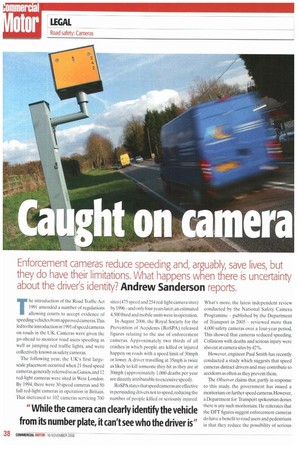Enforcement cameras reduce speeding and, arguably, save lives, but they
Page 38

Page 39

If you've noticed an error in this article please click here to report it so we can fix it.
do have their limitations. What happens when there is uncertainty about the driver's identity? Andrew Sanderson reports.
The introduction of the Road Traffic Act 1991 amended a number of regulations allowing courts to accept evidence of speeding vehicles from approved cameras.This led to the introduction in 1991 of speed cameras on roads in the UK. Cameras were given the go-ahead to monitor road users speeding as well as jumping red traffic lights, and were collectively known as safety cameras.
The following year. the UK's first largescale placement occurred when 21 fixed speed cameras,generally referred to as Gatsos, and 12 red-light cameras were sited in West London. By 1994, there were 30 speed cameras and 50 full red-light cameras in operation in Britain. That increased to 102 cameras servicing 700 sites (475 speed and 254 red-light camera sites) by 1996—and only four years later, an estimated 4,500 fixed and mobile units were in operation.
In August 2006. the Royal Society for the Prevention of Accidents (RoSPA) released figures relating to the use of enforcement cameras. Approximately two thirds of all crashes in which people are killed or injured happen on roads with a speed limit of 30mph or lower. A driver travelling at 35mph is twice as likely to kill someone they hit as they are at 30mph (approximately 1,000 deaths per year are directly attributable to excessive speed).
RoSPA states that speed cameras are effective in persuading drivers not to speed, reducing the number of people killed or seriously injured. What's more, the latest independent review conducted by the National Safety Camera Programme — published by the Department of Transport in 2005 — reviewed more than 4,000 safety cameras over a four-year period. This showed that cameras reduced speeding. Collisions with deaths and serious injury were also cut at camera sites by 42%.
However, engineer Paul Smith has recently conducted a study which suggests that speed cameras distract drivers and may contribute to accidents as often as they prevent them.
The Observer claims that, partly in response to this study, the government has issued a moritorium on further speed cameras. However, a Department for Transport spokesman denies there is any such moritoriurn. He reiterates that the DFT figures suggest enforcement cameras do have a benefit to road users and pedestrians in that they reduce the possibility of serious njury or death. But what happens to the -evenue generated by fines? Is it really a stealth .ax levied on drivers?
Fund manager?
Rc■,211 Lie generated from court fines and fixed penalties normally goes to the Consolidated Funds of the Exchequer. In April 2000, a new scheme was piloted whereby fines from speed and red-light cameras would pay for the cost of camera-enforcement activities.
In December 2005, though, the DfT announced it would change the funding arrangements from 2007/08 by establishing a new central fund for road safety. One drawback about speed cameras that is increasingly being aired in court is the question of the identity of the driver. It arises because, while the camera can clearly identify the vehicle from its number plate it cannot see who the driver is.
So when enforcement cameras identify a vehicle,documentation is sent to the registered owner asking him or her to identify the driver so that the fine may be sent to the appropriate individual. This should not be difficult where the vehicle is fitted with a tachograph. It should also be noted that tachographs are not accepted in court ass a defence against speeding because they do not accurately record the speed of the vehicle at a precise time.
It should he noted that anyone who untruthfully claims they were not driving can be prosecuted for perversion of justice.A man was jailed for two months this week for this offence.
One current case concerns a couple who were unsure who was driving the vehicle when the camera spotted it speeding. tinder English law, there is a provision that an individual is not required to incriminate themselves. The case -which has progressed to the European Court of Justice seeking a ruling on the prospects of them having to incriminate themselves I been heard, but as we go to press no decisi has been made.
If the European Court finds in favour of • couple, unless the camera can take a picti of the driver, it could lead to whoever w-a: the wheel stating they are not sure who N driving the vehicle,and they would be under obligation to incriminate themselves. makin difficult for the police to enforce fines agai individuals. This could lead to a change legislation by the government to close w might be regarded as a loophole. • • Andrew Sanderson is solicitor-advoc associate at Weightmans.
























































































































































































